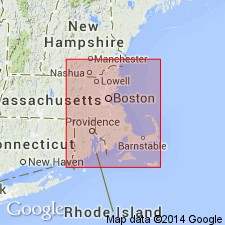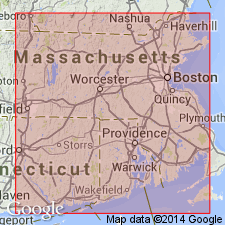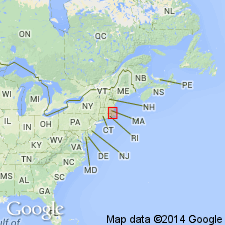
- Usage in publication:
-
- Grant Mills Granodiorite*
- Modifications:
-
- Age modified
- Areal extent
- AAPG geologic province:
-
- New England province
Summary:
Grant Mills Granodiorite is gradational with Esmond Granite according to Quinn (1971). Assigned a Proterozoic Z age. Does not project into MA.
Source: GNU records (USGS DDS-6; Reston GNULEX).

- Usage in publication:
-
- Grant Mills Granodiorite*
- Modifications:
-
- Overview
- AAPG geologic province:
-
- New England province
Summary:
In adjacent RI, used as Grant Mills Granodiorite of Proterozoic Z age. Gradational with Esmond Granite. [Does not extend into MA.]
Source: GNU records (USGS DDS-6; Reston GNULEX).

- Usage in publication:
-
- Grants Mills Granodiorite
- Modifications:
-
- Revised
- Overview
- Dominant lithology:
-
- Granodiorite
- AAPG geologic province:
-
- New England province
Summary:
The Esmond Plutonic Suite of this report consists predominantly of the Esmond Granite, but also includes the Grants Mills Granodiorite, which grades into the Esmond Granite in the Pawtucket quad., and an unnamed quartz diorite, which is intruded by the Esmond Granite. Grants Mills is gray to greenish gray and porphyritic, with a medium- to coarse-grained, massive to foliated and streaked matrix. Grants Mills is younger than some of the Esmond Plutonic Suite based on intrusive relations in the Pawtucket quad., but still considered Late Proterozoic. [Author uses original spelling of unit.]
Source: GNU records (USGS DDS-6; Reston GNULEX).

- Usage in publication:
-
- Grant Mills Granodiorite*
- Modifications:
-
- Overview
- AAPG geologic province:
-
- New England province
Summary:
Proterozoic Z Grant Mills Granodiorite occupies an area of 25 sq km in northeastern RI. Occurs in Dedham batholith. Intrudes older quartz diorite and is gradational with Esmond Granite (Quinn, 1971). Considered a porphyritic variety of Esmond by O.D. Hermes (written commun., 1985; Hermes and Zartman, 1985). Consists of pink and green granodiorite; similar in appearance to Dedham Granite. Some workers consider Grant Mills to be equivalent in age and texture to Dedham. Report includes geologic maps. [Papers presented as chapters in U.S. Geological Survey Professional Paper 1366 are intended as explanations and (or) revisions to MA State bedrock geologic map of Zen and others (1983) at scale of 1:250,000.]
Source: GNU records (USGS DDS-6; Reston GNULEX).
For more information, please contact Nancy Stamm, Geologic Names Committee Secretary.
Asterisk (*) indicates published by U.S. Geological Survey authors.
"No current usage" (†) implies that a name has been abandoned or has fallen into disuse. Former usage and, if known, replacement name given in parentheses ( ).
Slash (/) indicates name conflicts with nomenclatural guidelines (CSN, 1933; ACSN, 1961, 1970; NACSN, 1983, 2005, 2021). May be explained within brackets ([ ]).

